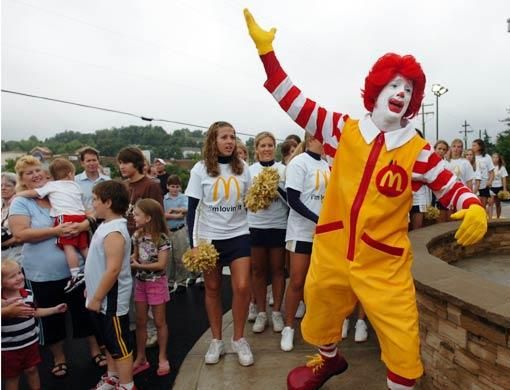McDonald's Big Mac, the triple-decker burger that helped breed America's super-size culture and restaurants' ever-expanding jumbo meals, is turning 40.
For some fast-food junkies, that is cause for celebration. "The flavours that come together - it's like heaven in your mouth," said April Kohlhaas, a 31-year-old Chicago resident. "It's just tradition, like American comfort food."
Although the McDonalds brothers established their first restaurant in California in 1940, the legendary burger was launched into history only in 1967 by McDonald's franchisee Jim Delligatti in Uniontown, Pennsylvania.
Seeing its popularity, a year later the chain put it on menus nationwide, and eventually around the world.
Since then, the sandwich has been a pop culture phenomenon, spawning everything from a well-known commercial jingle extolling its ingredients (Two all-beef patties, special sauce, lettuce, cheese, pickles, onions on a sesame seed bun) to a currency-evaluation index created by
The Economist, which compares the price of the sandwich in each market. The price ranges from $1.45 (Dh5.32) in China to $4.01 in Britain and a whopping $7.61 in Iceland, according to the magazine's most recent July tabulation.
Along the way, more people in more than 100 countries have given in to Big Mac attacks - especially in Japan, the second biggest market, according to Oak Brook, Illinois-based McDonald's Corp.
"The Big Mac is certainly one of our most popular sandwiches," said spokeswoman Danya Proud. "There is only one Big Mac and there will only ever be one Big Mac."
McDonald's estimates 550 million Big Macs are sold each year in the United States alone, about 17 per second. With 540 calories and 29 grams of fat each, it is enough to make nutritionists cringe.
"When it was eaten once in a while there wasn't anything wrong with it," said Marion Nestle, professor of nutrition and food studies at New York University's Steinhardt School of Culture, Education and Human Development. "It was just fast food, something fun once in a while. But then it became everyday fare."
Andrea Hawkins had her first Big Mac in high school and likes the treat so much she started the Facebook group "Big Mac-aholics".
She has put her Big Mac attacks on hiatus while she gets ready for her wedding next month. But that is not stopping her friends from building a cake-like tower of McDonald's hamburgers for her upcoming bachelorette party.
"[The] first treat on the way to the honeymoon will be a Big Mac," jokes the 25-year-old from Dayton, Ohio who prefers hers without cheese.
Dream come true
To celebrate the burger's anniversary, Delligatti, 89, and his family opened a Big Mac Museum Restaurant this week in North Huntingdon, Pennsylvania, full of memorabilia, celebratory exhibits and "the world's largest Big Mac statue".
"Forty years ago, I would never have dreamed that my creation would turn into a piece of Americana," said Delligatti, now 89.
Love them or hate them, the Big Mac has grown from its humble beginnings to become a cultural unifier, said pop culture expert and author Rachel Weingarten.
"You can live in Beijing or Brooklyn and you can enjoy as your favourite snack, a Big Mac attack," she said. "Maybe you didn't grow up watching the same cartoons, maybe you didn't grow up speaking the same language, maybe you grew up next door to each other and never said hello, but you suddenly have a point of reference - this warm, yummy, bad-for-you, sometimes-naughty thing."















